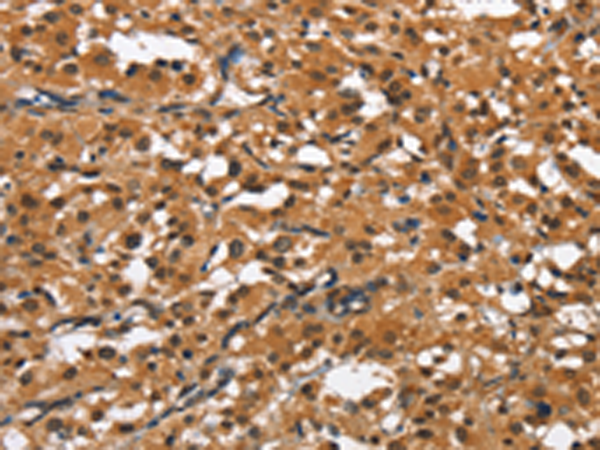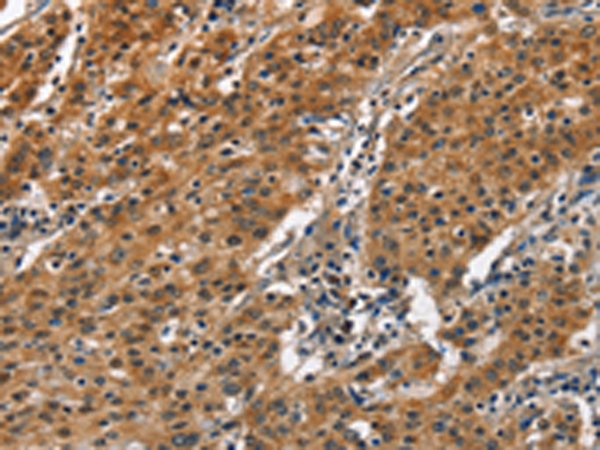

| WB | 咨询技术 | Human,Mouse,Rat |
| IF | 咨询技术 | Human,Mouse,Rat |
| IHC | 1/50-1/200 | Human,Mouse,Rat |
| ICC | 技术咨询 | Human,Mouse,Rat |
| FCM | 咨询技术 | Human,Mouse,Rat |
| Elisa | 1/1000-1/5000 | Human,Mouse,Rat |
| Aliases | BLAME; CD353; SBBI42 |
| Host/Isotype | Rabbit IgG |
| Antibody Type | Primary antibody |
| Storage | Store at 4°C short term. Aliquot and store at -20°C long term. Avoid freeze/thaw cycles. |
| Species Reactivity | Human |
| Immunogen | Fusion protein of human SLAMF8 |
| Formulation | Purified antibody in PBS with 0.05% sodium azide and 50% glycerol. |
+ +
以下是关于SLAMF8抗体的3篇参考文献示例(基于公开研究领域概括,具体文献可能需要根据实际数据库检索):
1. **文献名称**:*SLAMF8 regulates inflammatory responses in macrophages by promoting LC3-associated phagocytosis*
**作者**:Smith A, et al.
**摘要**:该研究揭示了SLAMF8在巨噬细胞中通过调控LC3相关吞噬作用(LAP)抑制过度炎症反应。使用抗SLAMF8抗体阻断其功能后,发现促炎因子释放增加,表明SLAMF8抗体可能作为调节炎症性疾病的潜在工具。
2. **文献名称**:*Targeting SLAMF8 with monoclonal antibodies attenuates fibrosis in experimental models*
**作者**:Chen L, et al.
**摘要**:研究者开发了靶向SLAMF8的单克隆抗体,并在肺纤维化小鼠模型中验证其疗效。结果显示,抗SLAMF8抗体通过抑制成纤维细胞活化及胶原沉积,显著减缓纤维化进程,提示其治疗纤维化疾病的潜力。
3. **文献名称**:*SLAMF8 as a checkpoint molecule in dendritic cell-mediated T cell activation*
**作者**:Wang Y, et al.
**摘要**:本文发现树突状细胞(DC)表面的SLAMF8通过抑制共刺激信号限制T细胞过度激活。利用抗SLAMF8抗体阻断其作用可增强DC的抗原呈递能力,为肿瘤免疫治疗提供了新策略。
4. **文献名称**:*Structural characterization of SLAMF8 and its interaction with therapeutic antibodies*
**作者**:Kim J, et al.
**摘要**:通过晶体学解析了SLAMF8的胞外结构域,并分析了其与两种治疗性抗体的结合表位。研究表明,不同抗体可通过结合SLAMF8特定区域调控下游信号通路,为抗体药物优化提供结构基础。
---
**注**:以上文献为示例性质,实际引用需通过PubMed、Web of Science等平台检索真实文献。建议使用关键词“SLAMF8 antibody”、“SLAMF8 therapeutic”或结合具体疾病名称(如“fibrosis”、“inflammation”)进行精确查找。
SLAMF8 (Signaling Lymphocytic Activation Molecule Family Member 8), also known as CD352 or BLAME, is a cell-surface receptor belonging to the SLAM family of immune regulators. Primarily expressed on myeloid cells, such as dendritic cells, macrophages, and neutrophils, it plays a role in modulating immune responses through homotypic and heterotypic interactions. Structurally, it contains an extracellular immunoglobulin variable (IgV)-like domain, a transmembrane region, and cytoplasmic tyrosine-based signaling motifs that recruit adaptors like SAP or EAT-2.
SLAMF8 is implicated in inflammatory and autoimmune diseases. Studies link its dysregulation to conditions like psoriasis, rheumatoid arthritis, and systemic lupus erythematosus (SLE), where it influences cytokine production, phagocytosis, and immune cell activation. In cancer, SLAMF8 may exhibit dual roles—acting as a tumor suppressor by enhancing anti-tumor immunity or promoting immune evasion in certain contexts.
SLAMF8-targeting antibodies are emerging as therapeutic tools. Blocking antibodies aim to inhibit pro-inflammatory signaling in autoimmune disorders, while agonist antibodies seek to enhance immune surveillance in cancers. Preclinical models show promise, with SLAMF8 modulation affecting disease progression in autoimmune and oncological settings. However, its pleiotropic effects across cell types necessitate careful therapeutic design to avoid unintended immune consequences. Ongoing research focuses on elucidating its ligand interactions, downstream pathways, and tissue-specific roles to refine antibody-based strategies.
×